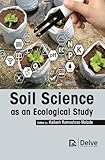Soil science as an ecological study / edited by Kailash Rameshrao Malode.
Material type: TextPublication details: Burlington, ON : Toronto Academic Press , c2023.Description: xviii, 254 pages : col. illus. ; 24 cmISBN:
TextPublication details: Burlington, ON : Toronto Academic Press , c2023.Description: xviii, 254 pages : col. illus. ; 24 cmISBN: - 9781774694534
- Ref 631.4 So34s 2023.
| Item type | Current library | Collection | Call number | Status | Barcode | |
|---|---|---|---|---|---|---|
 Books
Books
|
ASCOT Library - Zabali Campus Reference | Reference | Ref 631.4 So34s 2023. (Browse shelf(Opens below)) | Available | Ref6314004769 |
Browsing ASCOT Library - Zabali Campus shelves, Shelving location: Reference, Collection: Reference Close shelf browser (Hides shelf browser)

|

|

|

|

|

|

|
||
| Ref 629.89 P44p 2023. Programmable logic controllers / | Ref 630.2 St71a 2022 The agricultural dilemma: how not to feed the world / | Ref 631.4 P69s 2014 Soil science & management | Ref 631.4 So34s 2023. Soil science as an ecological study / | Ref 631.45 C31c 2023 The causes and effects of soil erosion / | Ref 632.5 M79w 2023. Weed and pest control / | Ref 633.88 P94p 2022 Production technology for medicinal and aromatic crops / |
Includes bibliographical references and index.
Chapter 1. Soil their variables/behavior --
Chapter 2. Soil formation --
Chapter 3. Soil classification and mapping --
Chapter 4. Soil fauna/ biology --
Chapter 5. Soil food web --
Chapter 6. Movement of soil water --
Chapter 7. Soil colloids --
Chapter 8. Soil organic matter --
Chapter 9. Thermal properties of soil --
Chapter 10. Soil preservation and management --
References --
Index.
"Soil provides a conducive ecosystem that's crucial for life: it serves as a plant growing channel and medium, apart from giving habitat to billions of creatures, adding to biodiversity, it also supplies the majority of the anti-microbial organisms used to fight infections. Likewise, people use soil as a holding chamber for solid waste, channel for wastewater, and foundation for urban communities and towns. Likewise, soil is the foundation of any country's agroecosystems which provide food, fiber, and fuel to run lives. This soil science volume provides an overview of how soil elements relate to and can be properly managed for ideal farming, woodlands, range, and wetlands management, metropolitan land use, garbage removal and so on.
Soil science incorporates scientific models from biology, chemistry, and physics to clarify how soils offer these fundamental solutions. Soil science offers comprehension of how soil properties interrelate and can be used for agrarian production, among other functions. Soil science incorporates scientific elements from biology, physics, and chemistry to explain practical agribusiness, worldwide biogeochemical cycles and environmental change, biological systems and capacity, and garbage removal, among other topics. Soil researchers use soil biogeochemical and physical elements, map soil qualities, and demonstrate soil processes. Soil researchers conduct soil surveys, create land use policies, perform site assessments for septic systems, inspect soil capacity and health, determine ideal food production techniques, create environmental change prevention strategies, and new methodologies for clean water production.
Soil researchers will generally fall into five areas of specialization: microbiology, edaphology, physical science, chemistry or pedology. However, their duties are especially directed by the challenges confronting human civilization, plus the qualifications between the sub-disciplines of soil science frequently interrelate all the while. Soil science experts ordinarily stay current in soil science, soil physical science, soil microbial science, pedology, and applied soil science in related disciplines. In soil science, depression storage capacity is the capacity of a specific area of land to hold water in its crevices and depressions, hence keeping it from flowing. Depression storage ability, alongside infiltration limit, are among the primary variables associated with Horton overland stream, by which water volume exceeds both infiltration and depression storing capacity and starts to move on a level plane across land, conceivably causing soil erosion and flooding. The research of land's depression storage range is significant in hydrology. A more conventional job for soil researchers has been soil mapping. Practically, every region in the world presently has a distributed soil review, which incorporates interpretive tables with regards to how soil properties function or preferred activities and uses. A universally acknowledged soil classification permits for uniform grouping of soil attributes and soil roles Both national and global sail review efforts have given rise to bits of knowledge about landscape properties across different geographical terrains. The perfect soil for plant growth contains half pore space and half solids, with the pore region containing a balance of air and water. This dispersion rarely happens on the grounds that pore space differs with soil texture and management. For instance, plowing increases pore space, while weak drainage and compaction decreases it." -- Provided by publisher.
There are no comments on this title.
